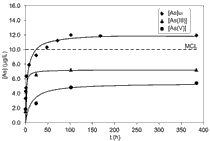Arsenic Release from Pyrite Ashes: Kinetic Studies
Keywords:
Pyrite ashes, arsenic, arsenite, arsenate, mobility, kineticsAbstract
Arsenic mobility in pyrite ashes was studied because of the possible effects on water systems. The batch extraction method was used to assess kinetics and extent of As release induced by contact of the material either with rainwater or groundwater. Self-established pH-Eh range of pyrite ashes/water mixtures brought both As(III) and As(V) to be present in the water phase, as neutral arsenite H3AsO3 and anionic arsenate HAsO42–, respectively. Tests in reagent water showed both rate and extent of arsenite release higher than arsenate; total As concentration ([As] = 12 μg/L) at equilibrium little exceeded its EU Maximum Concentration Level (MCL) for surface and groundwater ([As] = 10 μg/L). Tests in groundwater, instead, showed a much higher release rate and extent for arsenate than for arsenite and the chemistry of groundwater mainly influenced arsenate mobility; total As almost instantly exceeded its MCL and it was markedly higher ([As] = 31 μg/L) at equilibrium. Overall, the study has shown the environmental implications of As mobility in the pyrite ashes, also casting light on some limits of the environmental representativeness of leaching tests in reagent water.

Downloads
Published
Issue
Section
License
Except where otherwise noted, articles in this journal are published under the Creative Commons Attribution 4.0 International License
